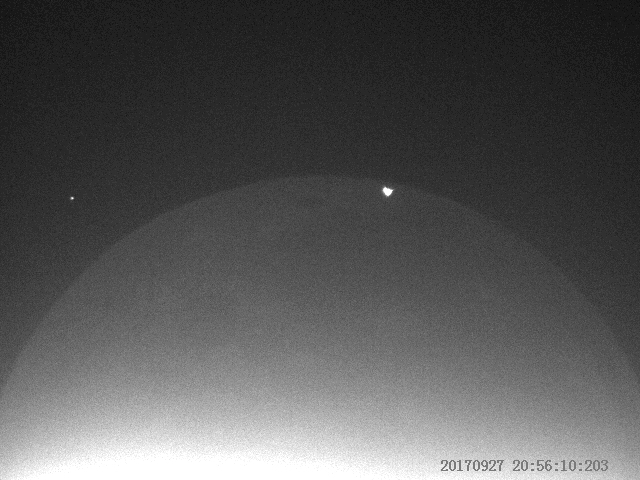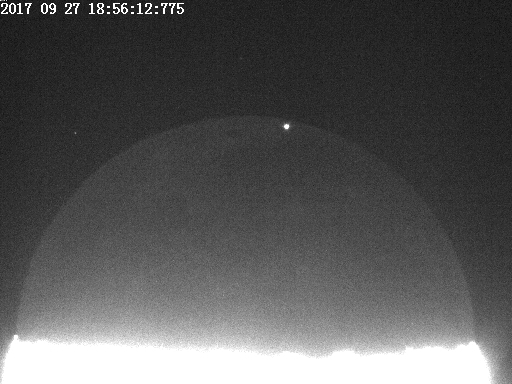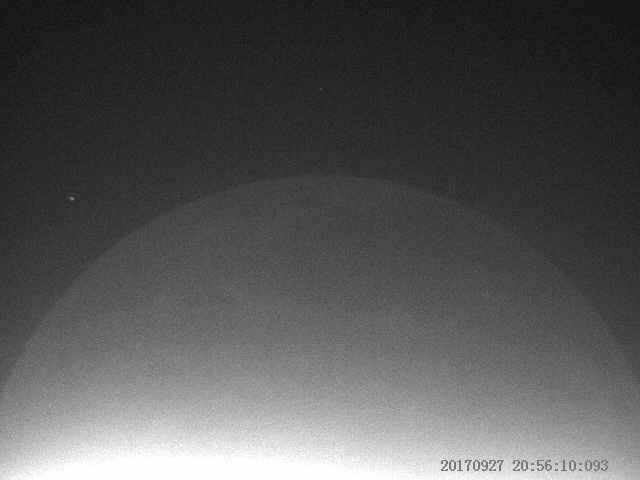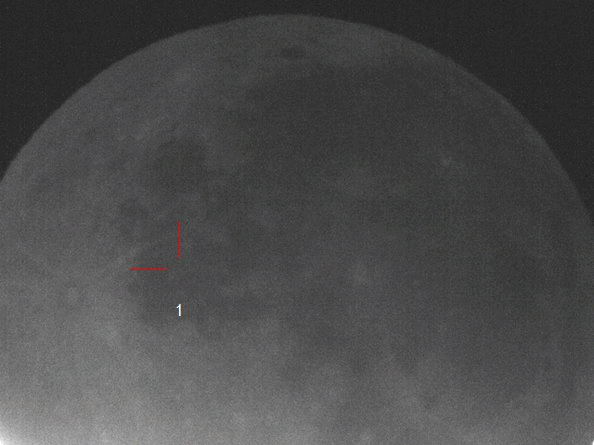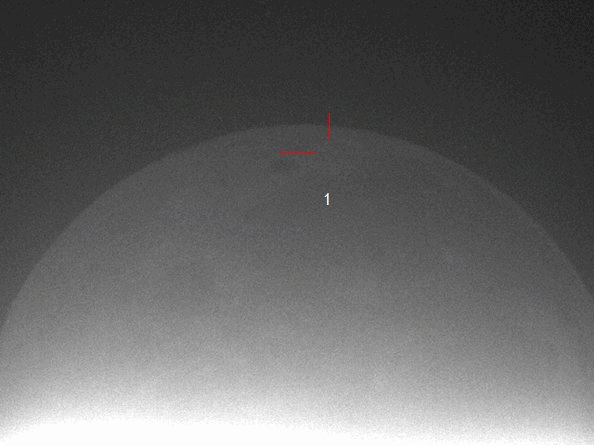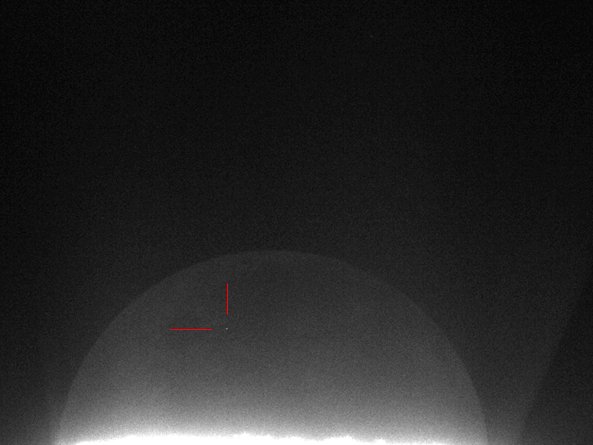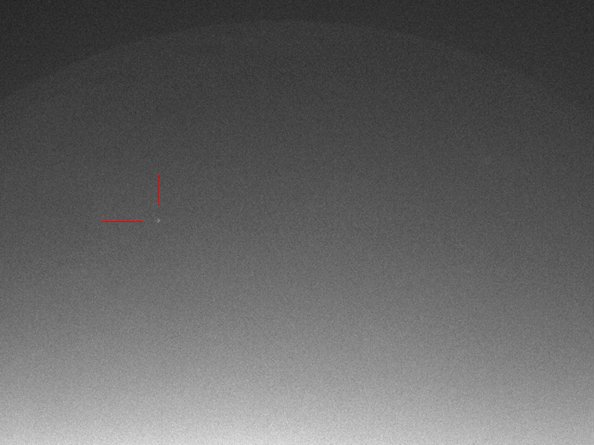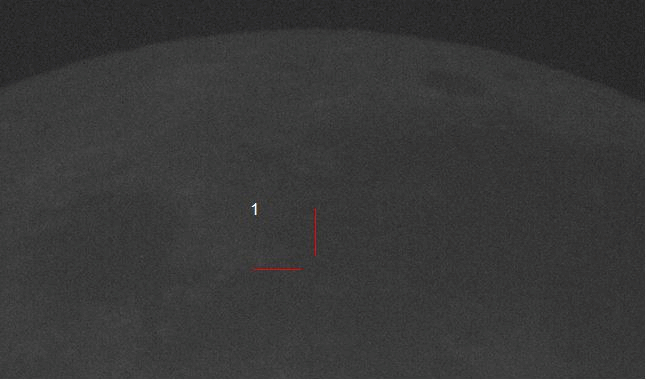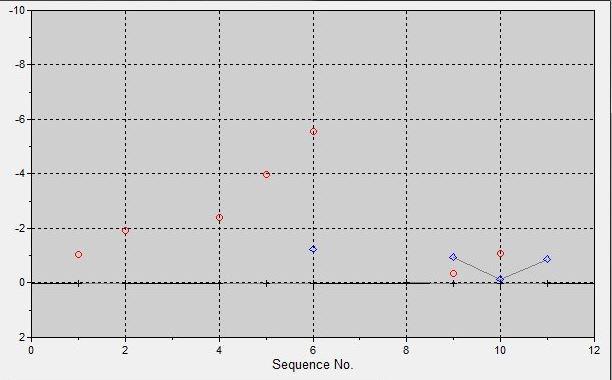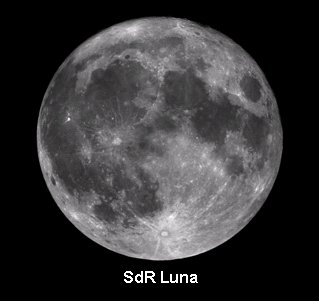Candidati Impatti registrati Recorded Impact flashes
I Candidati Impatti lunari registrati dalla SNdR Luna UAI nel biennio 2019-2020
The Lunar Impacts Candidates recorded by SNdR Luna UAI in the 2019-2020 years
Nel biennio 2019-2020 sono stati registrati dalla SNdR Luna UAI sei probabili flash da Impatto Lunare, e precisamente da Bruno Cantarella e Luigi Zanatta, membri della SNdR Luna UAI che operano con le proprie strumentazioni in questo campo di Ricerca, ed inoltre dall'osservatore indipendente Luigi Morrone che ha collaborato con la Sezione registrando in modo indipendente due dei sei flash da Impatto. Al seguente link è disponibile un articolo preliminare dove sono stati pubblicati in dettaglio i sei fenomeni luminosi da Impatto:
https://www.uai.it/sito/news/uai-ricerca/i-candidati-impatti-lunari-registrati-dalla-sndr-luna-uai-nel-biennio-2019-2020/ .
In the 2019 and 2020 years there was the record by SNdR Luna UAI of six probables lunar impact flashes, and more precisely by Bruno Cantarella and Luigi Zanatta members of the SNdR Luna UAI that with their astronomical instrumental setup make observations of earthshine, and also by the independent lunar observer Luigi Morrone that has collaborated with the same SNdR Luna UAI recording two of six ipact flashes. At the following link is available an preliminary article where are published with more informations these six impact flashes:
https://www.uai.it/sito/news/uai-ricerca/i-candidati-impatti-lunari-registrati-dalla-sndr-luna-uai-nel-biennio-2019-2020/ .
I Candidati Impatti lunari registrati dalla SNdR Luna UAI nel 2018
The Lunar Impacts Candidates recorded by SNdR Luna UAI on 2018 year
Nel 2018 sono stati registrati dalla SNdR Luna UAI quattro probabili flash da Impatto Lunare, e precisamente da Bruno Cantarella e Luigi Zanatta, membri della SNdR Luna UAI che operano con le proprie strumentazioni in questo campo di Ricerca. Al seguente link è disponibile un articolo preliminare dove sono stati pubblicati in dettaglio i quattro fenomeni luminosi da Impatto: https://www.uai.it/sito/news/uai-ricerca/i-candidati-impatti-lunari-registrati-dalla-sndr-luna-uai-nel-2018/ .
On 2018 year has been recorded by SNdR Luna UAI four probable impact flashes, and more precisely by Bruno Cantarella and Luigi Zanatta, members of the SNdR Luna UAI that with their astronomical instrumental work in this field of Research. At this link is available an preliminary article where show in details the four flashes:
https://www.uai.it/sito/news/uai-ricerca/i-candidati-impatti-lunari-registrati-dalla-sndr-luna-uai-nel-2018/ .
5° Candidato Impatto lunare registrato dalla SNdR Luna UAI
5° Lunar Impact Candidate recorded by SNdR Luna UAI
Un nuovo flash da Impatto di un meteoroide sulla superficie lunare è stato osservato e registrato in data 27 Settembre 2017 alle ore 18h 56m 12s TU dai membri della Sezione Nazionale di Ricerca Luna Bruno Cantarella e Luigi Zanatta dal sito osservativo di Melazzo (AL), alle coordinate geografiche di 44° 39' 25" Nord e 8° 25' 52" Est. L'osservazione e la registrazione del flash da Impatto è stata effettuata in contemporanea da due differenti telescopi, il principale costituito da un Newton 200/1000 con riduttore di focale ad f/2.9 con videocamera per Astronomia ZWO mod. ASI 120MM impostata ad una risoluzione dell'immagine di 640x480 in binning 2x2 ad un frame rate di 25 fps, e il secondario un telescopio Newton 100/400 ad f/4 con una seconda identica videocamera per Astronomia ZWO mod. ASI 120MM ad una risoluzione dell'immagine di 512x384 in binning 2x2 ad un frame rate di 30 fps. Al momento dell'osservazione entrambi gli strumenti erano installati in parallelo su una montatura equatoriale EQ6 della Skywatcher. Dalle primissime analisi svolte direttamente sul filmato in file AVI dal Responsabile della SNdR Luna e Coordinatore del Programma di Ricerca Impatti Lunari Antonio Mercatali, è stato verificato che il flash è visibile in 29 frames consecutivi, ed il tempo di durata del flash è risultato essere stato di 1,12 secondi (11,2 decimi di secondo) quindi di circa 11 volte superiore al tempo medio della durata di un classico flash da Impatto che è di circa 1 decimo di secondo. Di seguito sono pubblicate le due immagini del flash al picco di luminosità riprese dai due strumenti impiegati per le osservazioni, e per il tempo esatto di riferimento è quello segnato dal timestamp sull’immagine ripresa dal telescopio Newton 100/400 ed è espresso in TU.
A new important flash of an impact of one meteoroid on the lunar surface has been observed and recorded on 2017 September 27 at 18h 56m 12s UT by the members of Sezione Nazionale di Ricerca Luna UAI Bruno Cantarella and Luigi Zanatta from the observative site of Melazzo, AL, Italy, 44°39'25" North, 8°25'52" East. The observation and record of the impact flash has been made at the same time by two differents telescopes, the first a Newton telescope 200/1000 with a focal reducer at f/2.9 with astronomical videocamera ZWO mod. ASI 120MM at image resolution of 640x480 with binning 2x2 at frame rate of 25 fps, and the second a Newton telescope 100/400 at f/4 with an other identical astronomical videocamera ZWO mod. ASI 120MM at image resolution of 512x384 with binning 2x2 at frame rate of 30 fps. At the moment of observation and record of impact flash both the telescopes was installed in parallel mode on one equatorial mount EQ6 Skywatcher. From the first analysis made by Antonio Mercatali Responsible of SNdR Luna UAI and Coordinator of Lunar Impact Project, has been checked that the impact flash is visible in 29 consecutive frames, and the duration time of flash has been of 1,12 seconds (11,2 tenths of second) therefore with a time about 11 time upper of the medium duration of a classic impact flash that is about 1 tenth of second.
Under are published the two images of flash at the luminosity peak taken by two telescopes, and for the exact time UT of impact flash it is written in the timestamp on the image taken with telescope Newton 100/400.
Il flash al picco di luminosità ripreso dal telescopio Newton 200/1000 ad f/2,9
The flash at luminosity peak taken with Newton telescope 200/1000 at f/2,9
Il flash al picco di luminosità ripreso dal telescopio Newton 100/400 ad f/4
The flash at luminosity peak taken with Newton telescope 100/400 ad f/4
Di seguito è invece pubblicata l’animazione in formato gif del flash da Impatto ripreso dal telescopio Newton 200/1000 ad f/2,9 e la sequenza è stata composta con 23 frame ed il tempo di inizio del primo frame della sequenza è 20:56:10:093 (N.B. qui il tempo del timestamp è espresso in Ora Estiva).
Under is published the gif animation sequence of impact flash taken with Newton telescope 200/1000 at f/2,9 and the sequence has been compote with 23 frames and the time of start of first frame of sequence is 20:56:10:093 (N.B. here the time in the timestamp is express in Summer Italian Time, i.e. UT + 2h).
Sequenza animata del flash ripreso dal telescopio Newton 200/1000 ad f/2,9
Gif animation sequence of flash taken with Newton telescope 200/1000 at f/2,9
E' stata poi ricavata la posizione selenografica del flash da Impatto e le coordinate selenografiche ottenute sono alla Latitudine 8,0° Nord e Longitudine 76,5° Ovest, +/-1° su entrambe le coordinate selenografiche, e la zona lunare dell’impatto è stata individuata ad Est del cratere Glushko, a circa 20 km di distanza dal bordo Est del cratere.
Come per i precedenti Candidati Impatti già registrati dagli stessi membri della Sezione è stato effettuato il consueto invio dei dati osservativi al Marshall Space Flight Center della NASA che si occupa a livello professionale per la raccolta dei dati sugli Impatti Lunari dove il Team dei ricercatori statunitensi ha valutato in modo molto positivo il risultato ottenuto, e quindi i risultati saranno pubblicati sul rispettivo sito web dello stesso Centro NASA competente in materia.
Per maggiori informazioni su questo nuovo flash da Impatto consultare l'articolo preliminare disponibile al link:
https://www.uai.it/sito/news/uai-ricerca/5-candidato-impatto-lunare-registrato-dalla-sndr-luna-uai/ .
Has been then obtained the selenographic position of impact flash and the selenograpich coordinates are at Latitude 8,0° North and Longitude 76,5° West, +/-1° on both coordinates, and the lunar zone of impact should be at East of Glushko crater, to about 20 km of distance from East edge of crater.
As all Impacts Candidate already recorded by the same members of SNdR Luna UAI, has been made the send of observativies dates to NASA's Marshall Space Flight Center that work at professional level for to collect all dates on Lunar Impact from the lunar observers from the world, and the Team of NASA's MSFC has valued in very positive mode the work made by SNdR Luna UAI, and therefore the results will publish on the NASA's website.
For more information on this new impact flash at this link is available a preliminary article:
https://www.uai.it/sito/news/uai-ricerca/5-candidato-impatto-lunare-registrato-dalla-sndr-luna-uai/ .
4° Candidato Impatto lunare registrato dalla SdR Luna UAI
4° Lunar Impact Candidate recorded by SNdR Luna UAI
Un nuovo flash da Impatto di un meteoroide sulla superficie lunare è stato osservato e registrato in data 1 Gennaio 2017 alle ore 17:47:07 TU dai membri di Sezione Bruno Cantarella e Luigi Zanatta dal sito osservativo di Melazzo, AL, 44°39'25" Nord, 8°25'52" Est. L'osservazione e la registrazione del fenomeno luminoso da impatto è stata effettuata da un unico telescopio Newton 200/1000 con riduttore di focale ad f/2.9 con videocamera ZWO mod. ASI 120MM ad un frame rate di 25 fps, e ad una risoluzione dell'immagine di 640x480 in binning 2x2. Al momento dell'osservazione lo strumento era installato su una montatura equatoriale EQ6 della Skywatcher. Lo stesso flash da Impatto è stato registrato e quindi confermato anche dal Dott. Tony Cook della BAA. Dopo il consueto invio dei dati osservativi da parte del Coordinatore del Programma Impatti Lunari della SdR Luna al Marshall Space Flight Center della NASA, come nel caso dei precedenti Candidati Impatti registrati dagli stessi membri della Sezione, il Team dei ricercatori statunitensi ha valutato in modo positivo il risultato ottenuto ed ha classificato il nuovo flash come Candidato Impatto lunare n°31 nella lista degli osservatori indipendenti del NASA Meteoroid Environment Office Dalle analisi effettuate sempre dal Coordinatore del Programma Impatti Lunari della SdR Luna, Il fenomeno luminoso è durato circa 0,04 secondi (0,4 decimi di secondo), e la zona dell'impatto è stata individuata alle coordinate selenografiche di 18,,2° Ovest e 21,6° Sud +/-0,5° nella zona lunare situata a Nord-Nord-Est del cratere Wolf A e a Sud del cratere Gould B. Di seguito è pubblicata la sequenza delle immagini dove compare il fenomeno da impatto indicato da due linee rosse e ripreso dallo strumento impiegato per l'osservazione e la registrazione.
A new flash of an impact meteoroid on the lunar surface has been observed and recorded on 2017 January 1 at 17h 47m 07s UT by the members of SdR Luna UAI Bruno Cantarella and Luigi Zanatta from the observative site of Melazzo, AL, Italy, 44°39'25" North, 8°25'52" East. The observation and record of the impact bright phenomenon has been made by a unique Newton telescope 200/1000 with a focal reducer at f/2.9 with astronomical videocamera ZWO mod. ASI 120MM at frame rate of 25 fps, with image resolution of 640x480 binning 2x2. The telescope at the moment of observation was installed on equatorial mount EQ6 Skywatcher. Also the same flash Impact has been observed and recorded and therefore confirmed by the Dott. Tony Cook of the BAA. After the send of the observativies date by the Lunar Impact Project Coordinator of SdR Luna to NASA Marshall Space Flight Center, as in the case of the previous Impact Candidate recorded by the same members of our Lunar Section, the Team of American researchers has valued in positive mode the result obtain and has classified the new flash as Lunar Impact Candidate n° 31 in the list of Independent Observers of NASA Meteoroid Environment Office. From the analysis made always by the Lunar Impact Project Coordinator of SdR Luna, the duration of the phenomenon has been about 0.04 seconds (0.4 tenths of second), and the impact zone has been located at the selenographic coordinates of 18.2° West and 21.6° South +/-0.5° in the lunar zone at North-North-East of Wolf A crater, and at South of Gould B crater. The image visible below show the impact flash sequence indicate by two red lines.
Il flash da Impatto ripreso da Bruno Cantarella e Luigi Zanatta (Melazzo, AL), Newton 200/1000 ad f/2,9 con videocamera ASI 120MM
The Impact flash taken by Bruno Cantarella and Luigi Zanatta (Melazzo, AL, ITALY), Newton 200/1000 f/2,9 with videocamera ASI 120MM
3° Candidato Impatto lunare registrato dalla SdR Luna UAI
3° Lunar Impact Candidate recorded by SdR Luna UAI
In data 6 Novembre 2016 alle ore 17:43:12 TU i membri di Sezione Bruno Cantarella e Luigi Zanatta (Melazzo, AL, 44°39'25" Nord, 8°25'52" Est) hanno registrato il terzo flash di un impatto di un meteoroide sulla superficie lunare. L'osservazione e la registrazione del fenomeno luminoso da impatto è stata effettuata da un unico telescopio Newton 200/1000 ad f/2.9 con videocamera ZWO mod. ASI 120MM ad un frame rate di 25 fps con una risoluzione dell'immagine di 640x480 in binning 2x2. Al momento dell'osservazione lo strumento era installato su una montatura equatoriale EQ6 della Skywatcher. Attualmente il Candidato Impatto non è stato confermato da altri osservatori indipendenti. Dopo il consueto invio dei dati osservativi da parte del Coordinatore del Programma Impatti Lunari della SdR Luna al Marshall Space Flight Center della NASA, come nel caso del primo e secondo Candidato Impatto registrato dagli stessi membri della Sezione, il Team dei ricercatori statunitensi ha valutato in modo positivo il risultato ottenuto ed ha classificato il nuovo flash come Candidato Impatto lunare n°30 nella lista degli osservatori indipendenti del NASA Meteoroid Environment Office Il fenomeno è durato circa 0,08 secondi (1/12 sec.), e la zona dell'impatto è stata individuata alle coordinate selenografiche di 74,5° Ovest e 2,2° Nord +/-0,5° nella zona lunare situata a Nord di Grimaldi, e più precisamente a Sud del cratere Hedin F e a Nord-Nord-Est del cratere Riccioli H. Di seguito è pubblicata la sequenza delle immagini dove compare il fenomeno da impatto indicato da due linee rosse e ripreso dallo strumento impiegato per l'osservazione e la registrazione.
On 2016 November 6 at 17h 43m 12s UT the members of SdR Luna UAI Bruno Cantarella and Luigi Zanatta (Melazzo, AL, Italy, 44°39'25" North, 8°25'52" East) have recorded the third flash of meteoroid impact on the lunar surface. The observation and record of this impact flash has been made with one telecope Newton 200/1000 f/2.9 with astronomical videocamera ZWO mod. ASI 120MM at frame rate of 25 fps and image resolution of 640x480 binning 2x2. The telescope at the moment of observation was installed on equatorial mount EQ6 Skywatcher. At this moment the Impact Candidate it is not confirm by others independent observers. After the send of the observativies date by the Lunar Impact Project Coordinator of SdR Luna to NASA Marshall Space Flight Center, as in the case of first and second Impact Candidate recorded by the same members of our Lunar Section, the Team of American researchers has valued in positive mode the result obtain and has classified the new flash as Lunar Impact Candidate n° 30 in the list of Independent Observers of NASA Meteoroid Environment Office. The phenomenon is last about 0.08 seconds (1/12 sec.) and the impact zone has been located at the selenographic coordinates 74.5° Ovest and 2.2° North +/-0.5° in the lunar zone to North of Grimaldi, and more precisely at South of Hedin F crater and to North-North-East of Riccioli H crater. The image with the impact flash sequence indicate by two red lines is publish below.
Il flash da Impatto ripreso da Bruno Cantarella e Luigi Zanatta (Melazzo, AL), Newton 200/1000 ad f/2,9 con videocamera ASI 120MM
The Impact flash taken by Bruno Cantarella and Luigi Zanatta (Melazzo, AL, ITALY), Newton 200/1000 f/2,9 with videocamera ASI 120MM
2° Candidato Impatto lunare registrato dalla SdR Luna UAI
2° Lunar Impact Candidate recorded by SdR Luna UAI
In data 12 Giugno 2016 alle ore 20:26:59 TU i membri di Sezione Bruno Cantarella e Luigi Zanatta (Melazzo, AL, 44°39'25" Nord, 8°25'52" Est) hanno registrato il secondo flash di un impatto di un meteoroide sulla superficie lunare. L'osservazione e la registrazione del flash da impatto è stata effettuata da due telescopi diversi, un Newton 100/400 ad f/4 e un Newton 200/1000 ad f/5 con videocamere ZWO mod. ASI 120MM, ad un frame rate di 25 fps ad una risoluzione dell'immagine di 640x480. Entrambi i telescopi al momento delle osservazioni erano installati su una unica montatura equatoriale EQ6 della Skywatcher. Attualmente il Candidato Impatto non è stato confermato da altri osservatori indipendenti. Dopo l'invio dei dati osservativi da parte del Coordinatore del Programma Impatti Lunari al Marshall Space Flight Center della NASA, come nel caso del primo Candidato Impatto registrato dagli stessi membri della SdR Luna in data 12 Marzo 2016, il Team dei ricercatori statunitensi ha valutato in modo positivo il risultato ottenuto ed ha classificato il nuovo flash come Candidato Impatto lunare n°29 nella lista degli osservatori indipendenti del NASA Meteoroid Environment Office Il fenomeno è durato circa 0,04 secondi (1/24 sec.), e la zona dell'impatto è stata individuata alle coordinate selenografiche di 37,0° Ovest e 10,5° Sud +/-0,5° sempre nella parte meridionale dell'Oceanus Procellarum, e più precisamente a Sud-Est del cratere Scheele. Di seguito sono pubblicate le due immagini dove compare il fenomeno da impatto indicato da due linee rosse e ripreso dai due strumenti diversi impiegati per l'osservazione e la registrazione.
On 2016 June 12 at 20h 26m 59s UT the members of SdR Luna UAI Bruno Cantarella and Luigi Zanatta (Melazzo, AL, Italy, 44°39'25" North, 8°25'52" East) have recorded the second flash of meteoroid impact on the lunar surface. The observation and record of impact flash has been made with two different telecopes, Newton 100/400 f/4 and Newton 200/1000 f/5 with two astronomical videocamera ZWO mod. ASI 120MM at frame rate of 25 fps and image resolution of 640x480. Both the telescopes at the moment of observation was installed on only equatorial mount EQ6 Skywatcher. At this moment the Impact Candidate it is not confirm by others independent observers. After the send of the observativies date by the Lunar Impact Project Coordinator to NASA Marshall Space Flight Center, as in the case of first Impact Candidate recorded by the same members of SdR Luna UAI on 2016 March 12, the Team of American researchers has valued in positive mode the result obtain and has classified the new flash as Lunar Impact Candidate n° 29 in the list of Independent Observers of NASA Meteoroid Environment Office. The phenomenon is last about 0.04 seconds (1/24 sec.) and the impact zone has been located at the selenographic coordinates 37.0° Ovest and 10.5° Sud +/-0.5° always in the southern zone of Oceanus Procellarum, and more precisely at South-East of Scheele crater. The two images with the impact flash indicate by two red lines are publish below, and the flash has been taken by two different telescopes. used for the observation and record.
Il flash da Impatto ripreso da Bruno Cantarella (Melazzo, AL), Newton 100/400 ad f/4 con videocamera ASI 120MM
The Impact flash taken by Bruno Cantarella (Melazzo, AL), Newton 100/400 ad f/4 with videocamera ASI 120MM
Lo stesso flash da Impatto ripreso da Luigi Zanatta (Melazzo, AL), Newton 200/1000 ad f/5 con videocamera ASI 120MM
The same Impact flash taken by Luigi Zanatta (Melazzo, AL), Newton 200/1000 ad f/5 with videocamera ASI 120MM
Primo Candidato Impatto lunare registrato dalla SdR Luna UAI
First Lunar Impact Candidate recorded by SdR Luna UAI
Nell'immagine animata è visibile la sequenza del flash da impatto, con il picco nel frame 2 e in luminosità decrescente nel frame 3
In the animated image it is visible the sequence of impact flash, with the peak in the frame 2 and in decreasing luminosity in the frame 3
In data 12 Marzo 2016 alle ore 18h:33m:02s TU i membri di Sezione Bruno Cantarella e Luigi Zanatta (Melazzo, AL, 44°39'25" Nord, 8°25'52" Est) hanno registrato il primo flash di un impatto di un meteoroide sulla superficie lunare. L'osservazione e la registrazione è stata effettuata con un unico telescopio Newton 200/1000 ad f/5 con videocamera ZWO mod. ASI 120MM ad un frame rate di 25 fps ad una risoluzione dell'immagine di 1024x600. Attualmente il Candidato Impatto non è stato confermato da altri osservatori indipendenti. Dopo l'invio dei dati osservativi da parte del Coordinatore del Programma Impatti Lunari al Marshall Space Flight Center della NASA, il Team statunitense ha valutato in modo positivo il risultato ottenuto ed ha classificato il flash come candidato impatto lunare n°28 nella lista degli osservatori indipendenti del NASA Meteoroid Environment Office. E' stata effettuata inoltre dal Dott. Alessandro Marchini Responsabile dell'Osservatorio Astronomico dell'Università di Siena una prima curva di luce del flash da impatto che al momento del picco di luminosità è stato circa 250 volte più luminoso della superficie lunare intorno alla zona dell'impatto stesso. il fenomeno è durato circa 0,08 secondi (1/12 sec.), e la zona dell'impatto è stata individuata alle coordinate selenografiche di 39,9° Ovest e 8,0° Sud +/-0,5° nella parte meridionale dell'Oceanus Procellarum, e più precisamente a Sud-Ovest del cratere Wichmann B.
On 12 March 2016 at 18h 33m 02s UT the members of UAI Lunar Section Bruno Cantarella and Luigi Zanatta (Melazzo, AL, Italy, 44°39'25" North, 8°25'52" East) have recorded the first flash of impact of one meteoroid on the Lunar surface. The observation and the record has been made with one unique Newton telescope 200/1000 at f/5 with astronomical videocamera ZWO mod. ASI 120MM with a frame rate of 25 fps and image's resolution of 1024x600. Currently the Impact Candidate has been not confirmed by others indepedent observers. After the send of observatives data by the Lunar Impacts Project's Coordinator to NASA Marshall Space Fligth Center, the American Team has valued in positive mode the obtained result and has classified the flash as Lunar Impact Candidate n° 28 in the list of Independent Observers of NASA Meteoroid Environment Office. Also has been made by Dott. Alessandro Marchini Responsible of Astronomical Observatory of the University of Siena (Italy) a first light curve of impact flash that at the moment of the luminosity peak has been 250 units more bright than lunar surface around at the impact zone. The phenomenon it is lasted 0.08 seconds (1/12 sec.), and the impact zone has been detected at the selenographics coordinates of 39.9° West and 8.0° South +/-0.5°, in the southern zone of Oceanus Procellarum, and more precisely to South-West of the crater Wichmann B.
La sequenza del flash da impatto ottenuta con il software di analisi LunarScan 2.00
The sequence of the impact flash obtained with analysis software LunarScan 2.00
La curva di luce del flash ottenuta con il programma MaxIm DL5
The light curve of the flash obtained with MaxIm DL5 software
